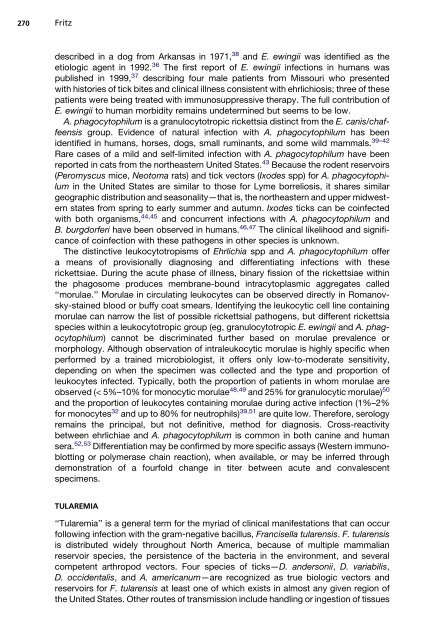Emerging Tick-borne Diseases - Uesc
Emerging Tick-borne Diseases - Uesc
Emerging Tick-borne Diseases - Uesc
You also want an ePaper? Increase the reach of your titles
YUMPU automatically turns print PDFs into web optimized ePapers that Google loves.
270<br />
Fritz<br />
described in a dog from Arkansas in 1971, 38 and E. ewingii was identified as the<br />
etiologic agent in 1992. 36 The first report of E. ewingii infections in humans was<br />
published in 1999, 37 describing four male patients from Missouri who presented<br />
with histories of tick bites and clinical illness consistent with ehrlichiosis; three of these<br />
patients were being treated with immunosuppressive therapy. The full contribution of<br />
E. ewingii to human morbidity remains undetermined but seems to be low.<br />
A. phagocytophilum is a granulocytotropic rickettsia distinct from the E. canis/chaffeensis<br />
group. Evidence of natural infection with A. phagocytophilum has been<br />
identified in humans, horses, dogs, small ruminants, and some wild mammals. 39–42<br />
Rare cases of a mild and self-limited infection with A. phagocytophilum have been<br />
reported in cats from the northeastern United States. 43 Because the rodent reservoirs<br />
(Peromyscus mice, Neotoma rats) and tick vectors (Ixodes spp) for A. phagocytophilum<br />
in the United States are similar to those for Lyme borreliosis, it shares similar<br />
geographic distribution and seasonality—that is, the northeastern and upper midwestern<br />
states from spring to early summer and autumn. Ixodes ticks can be coinfected<br />
with both organisms, 44,45 and concurrent infections with A. phagocytophilum and<br />
B. burgdorferi have been observed in humans. 46,47 The clinical likelihood and significance<br />
of coinfection with these pathogens in other species is unknown.<br />
The distinctive leukocytotropisms of Ehrlichia spp and A. phagocytophilum offer<br />
a means of provisionally diagnosing and differentiating infections with these<br />
rickettsiae. During the acute phase of illness, binary fission of the rickettsiae within<br />
the phagosome produces membrane-bound intracytoplasmic aggregates called<br />
‘‘morulae.’’ Morulae in circulating leukocytes can be observed directly in Romanovsky-stained<br />
blood or buffy coat smears. Identifying the leukocytic cell line containing<br />
morulae can narrow the list of possible rickettsial pathogens, but different rickettsia<br />
species within a leukocytotropic group (eg, granulocytotropic E. ewingii and A. phagocytophilum)<br />
cannot be discriminated further based on morulae prevalence or<br />
morphology. Although observation of intraleukocytic morulae is highly specific when<br />
performed by a trained microbiologist, it offers only low-to-moderate sensitivity,<br />
depending on when the specimen was collected and the type and proportion of<br />
leukocytes infected. Typically, both the proportion of patients in whom morulae are<br />
observed (< 5%–10% for monocytic morulae 48,49 and 25% for granulocytic morulae) 50<br />
and the proportion of leukocytes containing morulae during active infection (1%–2%<br />
for monocytes 32 and up to 80% for neutrophils) 39,51 are quite low. Therefore, serology<br />
remains the principal, but not definitive, method for diagnosis. Cross-reactivity<br />
between ehrlichiae and A. phagocytophilum is common in both canine and human<br />
sera. 52,53 Differentiation may be confirmed by more specific assays (Western immunoblotting<br />
or polymerase chain reaction), when available, or may be inferred through<br />
demonstration of a fourfold change in titer between acute and convalescent<br />
specimens.<br />
TULAREMIA<br />
‘‘Tularemia’’ is a general term for the myriad of clinical manifestations that can occur<br />
following infection with the gram-negative bacillus, Francisella tularensis. F. tularensis<br />
is distributed widely throughout North America, because of multiple mammalian<br />
reservoir species, the persistence of the bacteria in the environment, and several<br />
competent arthropod vectors. Four species of ticks—D. andersonii, D. variabilis,<br />
D. occidentalis, and A. americanum—are recognized as true biologic vectors and<br />
reservoirs for F. tularensis at least one of which exists in almost any given region of<br />
the United States. Other routes of transmission include handling or ingestion of tissues


